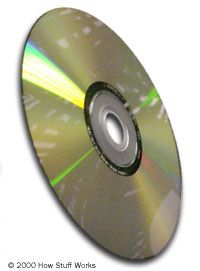DVD Discs
A DVD is very similar to a CD, but it has a much larger data capacity. A standard DVD holds about seven times more data than a CD does. This huge capacity means that a DVD has enough room to store a full-length, MPEG-2-encoded movie, as well as a lot of other information.
Here are the typical contents of a DVD movie:
Advertisement
- Up to 133 minutes of high-resolution video, in letterbox or pan-and-scan format, with 720 dots of horizontal resolution (The video compression ratio is typically 40:1 using MPEG-2 compression.)
- Soundtrack presented in up to eight languages using 5.1 channel Dolby digital surround sound
- Subtitles in up to 32 languages
DVD can also be used to store almost eight hours of CD-quality music per side.
The format offers many advantages over VHS tapes:
- DVD picture quality is better, and many DVDs have Dolby Digital or DTS sound, which is much closer to the sound you experience in a movie theater.
- Many DVD movies have an on-screen index, where the creator of the DVD has labeled many of the significant parts of the movie, sometimes with a picture. With your remote, if you select the part of the movie you want to view, the DVD player will take you right to that part, with no need to rewind or fast-forward.
- DVD players are compatible with audio CDs.
- Some DVD movies have both the letterbox format, which fits wide-screen TVs, and the standard TV size format, so you can choose which way you want to watch the movie.
- DVD movies may have several soundtracks on them, and they may provide subtitles in different languages. Foreign movies may give you the choice between the version dubbed into your language, or the original soundtrack with subtitles in your language.
